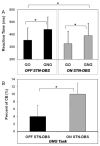Stimulation of the subthalamic nucleus and impulsivity: release your horses
- PMID: 20035509
- PMCID: PMC2972250
- DOI: 10.1002/ana.21795
Stimulation of the subthalamic nucleus and impulsivity: release your horses
Abstract
Objective: In Parkinson disease (PD) patients, deep brain stimulation (DBS) of the subthalamic nucleus (STN) may contribute to certain impulsive behavior during high-conflict decisions. A neurocomputational model of the basal ganglia has recently been proposed that suggests this behavioral aspect may be related to the role played by the STN in relaying a "hold your horses" signal intended to allow more time to settle on the best option. The aim of the present study was 2-fold: 1) to extend these observations by providing evidence that the STN may influence and prevent the execution of any response even during low-conflict decisions; and 2) to identify the neural correlates of this effect.
Methods: We measured regional cerebral blood flow during a Go/NoGo and a control (Go) task to study the motor improvement and response inhibition deficits associated with STN-DBS in patients with PD.
Results: Although it improved Unified Parkinson Disease Rating Scale motor ratings and induced a global decrease in reaction time during task performance, STN-DBS impaired response inhibition, as revealed by an increase in commission errors in NoGo trials. These behavioral effects were accompanied by changes in synaptic activity consisting of a reduced activation in the cortical networks responsible for reactive and proactive response inhibition.
Interpretation: The present results suggest that although it improves motor functions in PD patients, modulation of STN hyperactivity with DBS may tend at the same time to favor the appearance of impulsive behavior by acting on the gating mechanism involved in response initiation.
Conflict of interest statement
Potential conflict of interest: Nothing to report.
Figures



References
-
- Limousin P, Pollak P, Benazzouz A, et al. Effect of parkinsonian signs and symptoms of bilateral subthalamic nucleus stimulation. Lancet. 1995;345:91–95. - PubMed
-
- Kleiner-Fisman G, Herzog J, Fisman DN, et al. Subthalamic nucleus deep brain stimulation: summary and meta-analysis of outcomes. Mov Disord. 2006;21(suppl 14):S290–S304. - PubMed
-
- Jahanshahi M, Ardouin CM, Brown RG, et al. The impact of deep brain stimulation on executive function in Parkinson’s disease. Brain. 2000;123(pt 6):1142–1154. - PubMed
-
- Schroeder U, Kuehler A, Haslinger B, et al. Subthalamic nucleus stimulation affects striato-anterior cingulate cortex circuit in a response conflict task: a PET study. Brain. 2002;125:1995–2004. - PubMed
-
- Hershey T, Revilla FJ, Wernle A, et al. Stimulation of STN impairs aspects of cognitive control in PD. Neurology. 2004;62:1110–1114. - PubMed
Publication types
MeSH terms
Grants and funding
LinkOut - more resources
Full Text Sources
Other Literature Sources

